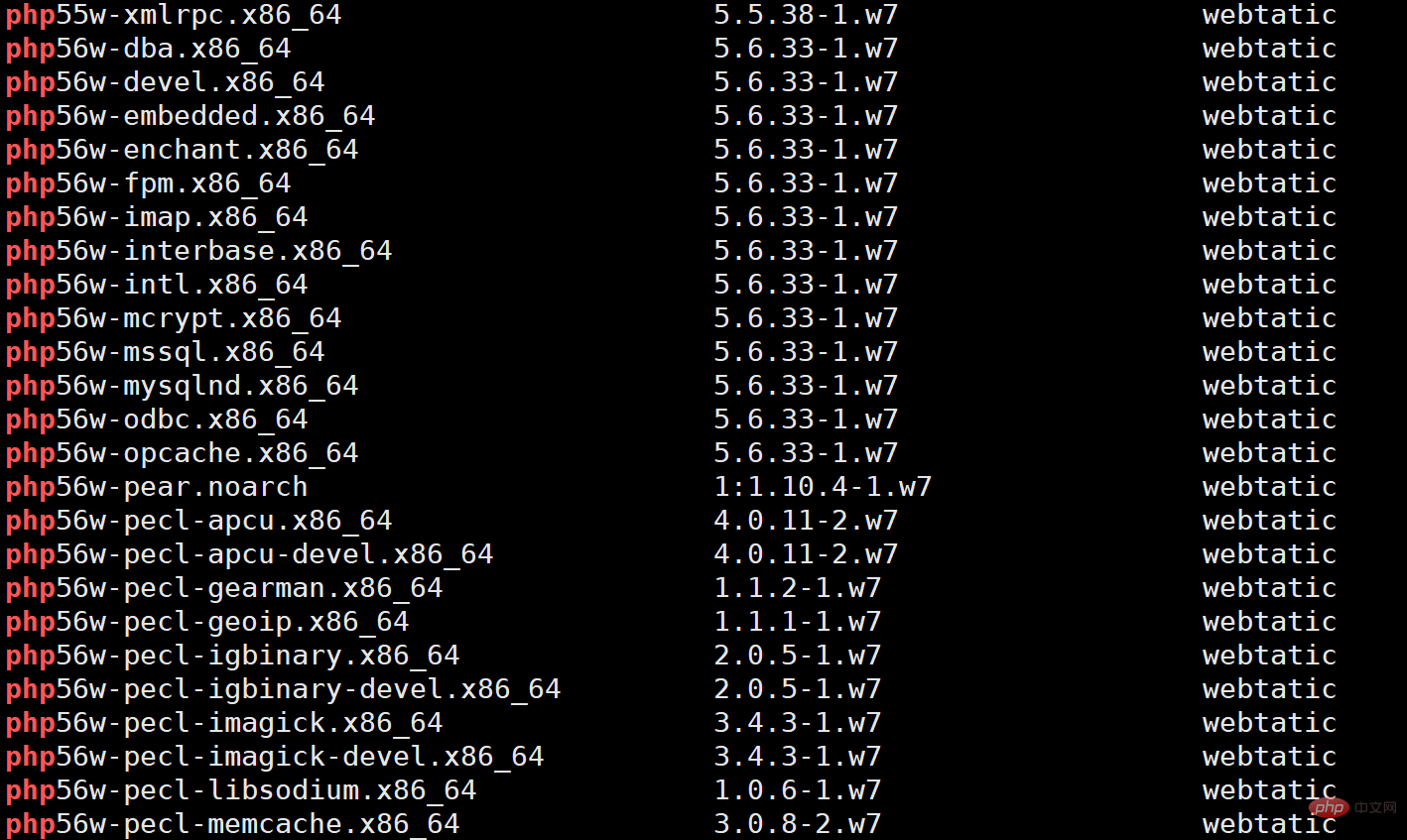How to upgrade the php version installed by default yum
The method to upgrade the php version installed by yum is: first set the yum source; then use the command "yum list | grep php" to view; then execute the command "yum -y install php56w" to install a higher version of php. Can.

CentOS7.2yum installation php default version is 5.4, you can upgrade to install a higher version through yum
Setting yum source
rpm -Uvh https://mirror.webtatic.com/yum/el7/webtatic-release.rpm
View
yum list |grep php

Install a higher version of php
yum -y install php56w
For more related knowledge, please visit PHP Chinese website!
The above is the detailed content of How to upgrade the php version installed by default yum. For more information, please follow other related articles on the PHP Chinese website!

Hot AI Tools

Undresser.AI Undress
AI-powered app for creating realistic nude photos

AI Clothes Remover
Online AI tool for removing clothes from photos.

Undress AI Tool
Undress images for free

Clothoff.io
AI clothes remover

AI Hentai Generator
Generate AI Hentai for free.

Hot Article

Hot Tools

Notepad++7.3.1
Easy-to-use and free code editor

SublimeText3 Chinese version
Chinese version, very easy to use

Zend Studio 13.0.1
Powerful PHP integrated development environment

Dreamweaver CS6
Visual web development tools

SublimeText3 Mac version
God-level code editing software (SublimeText3)

Hot Topics
 Detailed explanation of the steps to upgrade gcc using yum on CentOS6.5
Dec 31, 2023 am 10:59 AM
Detailed explanation of the steps to upgrade gcc using yum on CentOS6.5
Dec 31, 2023 am 10:59 AM
Because C++11 needs to be used, but the gcc4.4.7 that comes with CentOS does not support it, I decided to upgrade gcc. The operation is as follows: #Backup mv/etc/yum.repos.d/devtools-2.repo/etc/yum.repos.d/devtools-2.repo.bakwgethttp://people.centos.org/tru/devtools-2 /devtools-2.repo-O/etc/yum.repos.d/devtools-2.repoyuminstalldevtoolset-2-gccdevtoolse
 PHP version development history (1995-2022)
Jun 01, 2020 pm 01:59 PM
PHP version development history (1995-2022)
Jun 01, 2020 pm 01:59 PM
As a PHP learner and developer, how can I not understand its history? The following PHP Chinese website will lead PHP enthusiasts to review the various historical versions of PHP.
 Centos offline installation of Chinese version of GitLab
Feb 19, 2024 am 11:36 AM
Centos offline installation of Chinese version of GitLab
Feb 19, 2024 am 11:36 AM
1. Download the gitlab installation package. Download the latest Chinese version of the gitlab installation package from [Tsinghua University Open Source Software Mirror Station]. The installation package comes with a simplified Chinese localization package. Download the latest gitlab installation package from [gitlab official website]. 2. Install gitlab, take gitlab-ce-14.9.4-ce.0.el7.x86_64 as an example, upload it to the centos server and use yum to install gitlabyum-yinstallgitlab-ce-14.3.2-ce.0.el7.x86_64. rpm uses yum to install gityum-yinstallgit#Install git and modify the gitlab configuration file vi
 What is the difference between Linux package management tools yum and apt?
May 30, 2023 am 09:53 AM
What is the difference between Linux package management tools yum and apt?
May 30, 2023 am 09:53 AM
Generally speaking, famous Linux systems are basically divided into two categories: RedHat series: Redhat, Centos, Fedora, etc.; Debian series: Debian, Ubuntu, etc. yum (YellowdogUpdater, Modified) is a Shell front-end package manager in Fedora, RedHat and SUSE. apt (AdvancedPackagingTool) is a shell front-end package manager in Debian and Ubuntu. Overview Generally speaking, the famous Linux systems are basically divided into two categories: RedHat series: Redhat, Cento
 How to delete php in centos7+yum
Jan 19, 2023 am 10:00 AM
How to delete php in centos7+yum
Jan 19, 2023 am 10:00 AM
How to delete php in centos7 yum: 1. Check the PHP version through "php -v"; 2. Use "rpm -qa|grep php" to check the installed PHP related extensions; 3. Uninstall php by executing the "yum remove php" command That’s it.
 What tool is linux yum?
Feb 10, 2023 am 10:09 AM
What tool is linux yum?
Feb 10, 2023 am 10:09 AM
In Linux, yum is a software package manager that exists specifically to solve package dependencies; yum is an improved RPM software manager, which solves the package dependency problems faced by RPM. When the administrator uses yum to install an RPM package, yum will first download the dependency file of the package from the server side, and then download and install all related RPM packages from the server side at once by analyzing this file.
 How to use yum to install php on linux
Jan 29, 2023 am 09:46 AM
How to use yum to install php on linux
Jan 29, 2023 am 09:46 AM
How to install php using yum on Linux: 1. Execute the "mkdir /usr/local/php" command; 2. Download the updated installation package of the yum source; 3. Install the relevant yum source installation package; 4. Install through the "yum install" command php is enough.
 What is the role of yum in Linux? What are its main functions?
Feb 19, 2024 pm 05:30 PM
What is the role of yum in Linux? What are its main functions?
Feb 19, 2024 pm 05:30 PM
Everyone may be familiar with yum in Linux systems, but beginners may not know it. This article will introduce what yum is and its functions. Please read on. In Linux, yum is a package manager used to manage and install software packages. It is the abbreviation of YellowdogUpdater, Modified. It was originally designed for the RedHat series of distributions, but is now also used by many other RPM-based Linux distributions. The main functions of the YUM command include: YUM is a software package management tool that can be used to find, install, update and uninstall software packages. Through the YUM command, users can easily manage software packages on the system and automatically resolve differences between software packages.






